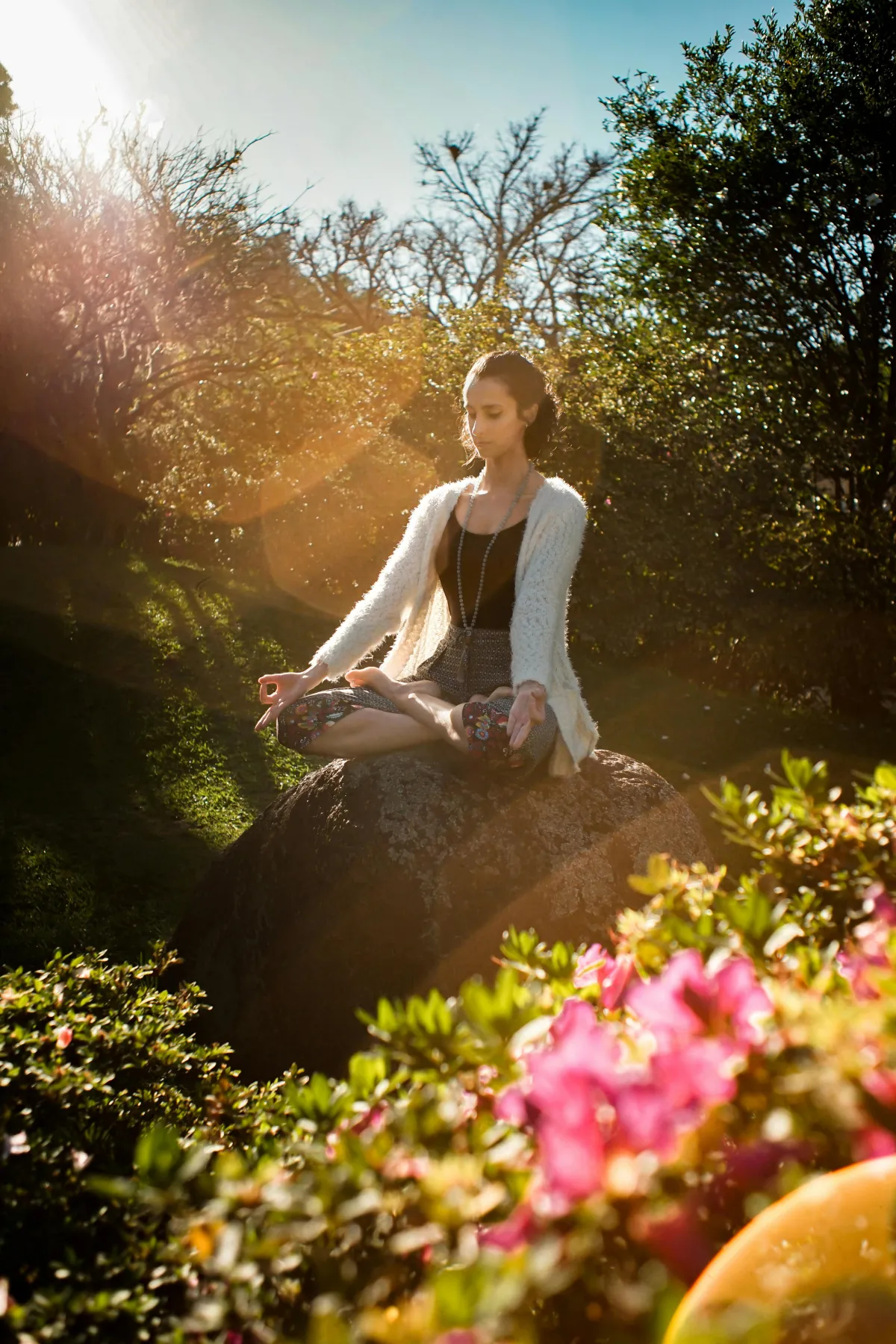Spiritual Coaching & Energy Healing for Real-Life Transformation
5⭐ International Spiritual Coach
You Were Never Broken. You’ve Just Been Living In Disconnection.

Meditation Spot: 8 Top Tips To Your Zen Journey
Introduction
For the majority, meditation can be likened to marmite—you either love it or find it challenging. For those of you who struggle with it, I hear you! It can be time-consuming and difficult when you first try. My advice: don’t give up. Instead, take a moment and read through my tried and tested tips. The hard bit has already been completed, so you can sit back and relax while I share my insights.
When I first started my meditation journey, I thought I couldn't meditate because my mind was too busy. I couldn’t focus or "clear my mind" as one should to meditate effectively. However, understanding meditation better, I've learned this is not actually an issue.
Meditation helps calm the mind, body, and spirit, so I often found myself thinking, "Why is it stressing me out more than calming me?" The answer came when I realised I had the wrong ideas about meditation.
There are different types of meditation, each beneficial in various ways. The first thing to do is find what works for you. Meditation isn’t necessarily about clearing your mind or staying still. Below, I’ll list some of the most common Meditation Styles before I let you in on my tips. Why? Because it will give you a better idea of which one will be best for you, and then you can use these handy tips to enjoy.
Common Meditation Styles
Vipassana / Silent Meditation
An ancient style of meditation originally taught by Buddha. This focuses on breathwork and mindfulness, asking you to take note of any thoughts, feelings, and actions that come to you during this time. These insights should be allowed to rise and pass without attachment. For me, this was the most difficult to practice, but many enjoy this to the extent of signing up for multi-day retreats—though it’s not ideal if you overthink.
Mantra Meditation
As the name suggests, this meditation involves repeating a word, phrase, or syllable (the mantra) over and over. In theory, this assists with mental clarity and focus. This style is rooted in Hindu and Buddhist teachings, among others.
Mindfulness Meditation / Present-Moment Meditation
Mindfulness meditation helps us refocus on the present moment. It involves bringing attention to the present moment. Often, our thoughts dwell on the past or venture into the future, leaving little time in the now. To practise this, start by concentrating on your breathing and then take note of your surroundings using your heightened senses. Gradually, you'll notice thoughts and emotions come and go, allowing you to sit with them before gently imagining them floating away.
This was the first meditation technique I mastered without even realising I was meditating. Living with fibromyalgia and chronic fatigue made falling asleep a challenge due to overthinking. I realised I needed a strategy to bring me into “the now,” closing down anything that had been done or needed doing in the future. Much like shutting down all the tabs on a laptop. Mentally I would go through all open tabs in my mind, determining whether they needed more attention, should be added to my "to-do" list, or could be discarded.
This method not only helped me get organised but also improved my ability to sleep better. By attending to my mind's chatter, I spent a few minutes in this state before switching off to enjoy the calm in the present moment.
Guided Meditation
This style relies on a voice guiding you. This can be a pre-recorded voice or someone guiding you in real-time, often through visualisations or imagery. I start my day with this type of meditation to help me ground and protect myself before facing the day—it works every time.

Visualisation Meditation
While related to guided meditation, this technique stands alone as you visualise specific images to invoke desired feelings. This can be especially helpful for manifestation practices.
Chakra Meditation
As a Reiki practitioner, I find this style valuable. Chakras are the body's energy centres, and they can become unbalanced or blocked. This meditation focuses on bringing attention to any of the seven main chakras, from the base of your spine to the top of your head. Working to release anything in the energy centers as desired.
Spiritual Meditation
One for all you spiritual seekers, this meditation allows you to connect to something bigger—whether you call it God, the Universe, or the Divine. Trust in the process. I'm told this involves concentration on your breath or repeating affirmations, helping you to connect on a deeper level. Honestly, I've only achieved this level via self-reiki.
Handy Tips for Meditation
TIP 1:
If thoughts drift in, that’s fine. Acknowledge them as they drift in, Thank them and allow them to drift out—don’t let them stress you out.
TIP 2:
Focusing on your third eye (the space in the middle of your forehead) or the tip of your nose can help clear the mind. But this is not essential.
TIP 3:
Concentrate on your breathing and take deeper breaths than usual to help still the mind. However if you suffer with dizzy spells be mindful you don't go too deep.
TIP 4:
Use mantra meditation or visualisation to give you a focus, if needed.
TIP 5:
Pace yourself. I started with 30-minute meditations, but after finding them uncomfortable, I reduced them to 10 minutes. Gradually increasing the time allowed me to handle longer durations. A little meditation is better than none.
TIP 6:
Find a Meditation Style that fits your needs and lifestyle.
TIP 7:
Know you do not need to be sitting cross legged and very still to benefit from meditation. Find a comfortable position, the more at ease you feel the more you will see results. There are some forms of meditation where movement is requirement.
TIP 8:
Stop overthinking and enjoy
Benefits of Meditation
We spend most of our days in our thinking mind (the masculine). Meditation takes us out of our minds and into our bodies, allowing us to connect with the feminine. This practice quiets our minds and brings our body, mind, and spirit to a tranquil place. It’s through meditation that we can listen to and connect with our intuition. It’s true what they say: if you sit with a problem long enough, the answer will come to you. At first, I didn’t believe this. Even when I received my first answer, I thought it was a fluke. However, after more practice, I realised it’s true. I’m still amazed by the magic each time.
Other benefits of meditation include:
Reduces stress
Controls anxiety
Promotes emotional health
Enhances self-awareness
Lengthens attention span
May reduce age-related memory loss
Can generate kindness
Improves sleep
Helps control pain
Decreases blood pressure
Conclusion
Meditation is a personal journey and, like any journey, it has its ups and downs. As a teenager, I started with Vipassana after someone suggested it to me. It didn't go as I had hoped. I never tried meditation again until I was pregnant, but the voice and music of the guided meditation didn’t connect with me. I thought I was done with meditation until I realised I'd been practising Mindfulness Meditation without knowing it. It helped me switch off at night, and I continued using this and experimenting.
Realising how beneficial it was, I began exploring other forms of meditation and mindfulness. Eventually, I found that even guided meditations worked once I found the right voice and music. Pregnancy may have reduced my tolerance, but perseverance led me to a revelation.
The key is to stay curious and gentle with yourself as you explore different styles and techniques. Remember, meditation isn't about perfection; it's about finding what works best for you and integrating it into your daily routine.
Whether you’re seeking to calm a busy mind, improve your focus, or connect more deeply with your spiritual self, there is a form of meditation that can support your personal needs. The benefits of meditation extend far beyond the practice itself, influencing your overall well-being, productivity, and sense of inner peace.
I hope my insights and tips have inspired you to give meditation a genuine try. It’s a tool that has profoundly shaped my life, and I believe it has the potential to do the same for you. Take it one step at a time, and remember, the journey is as important as the destination.
Thank you for joining me on this exploration of meditation.I’d love to hear about your experiences or any questions you might have. What resonates with you from this blog, and what are you eager to try next?
Looking for more helpful tips and insights? Be sure to check out my other blog posts for additional guidance and inspiration.
If you're seeking personalised 1-2-1 support, I invite you to use my booking calendar to schedule a discovery call. This is the perfect first step toward your journey to tranquility.
Alternatively, consider enrolling in my online course, "Living Your Best Life: Mastering Work-Life Harmony." This course delves into essential mindset shifts for achieving balance and so much more to help you kickstart your balanced living.




